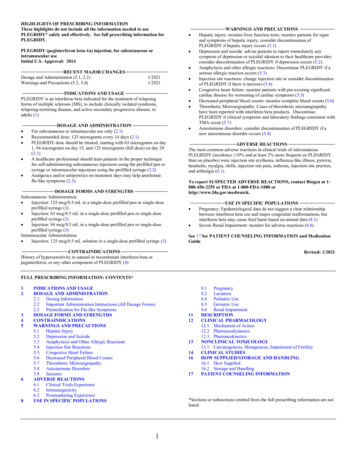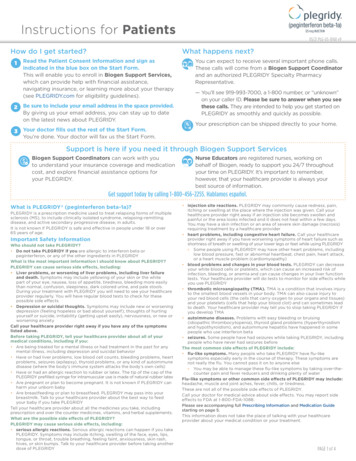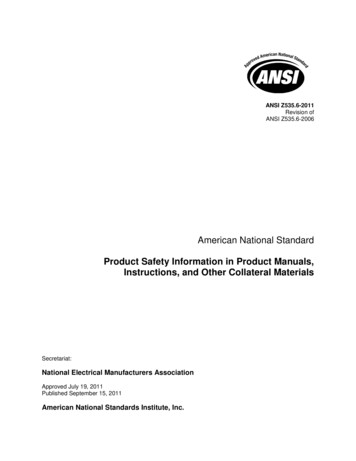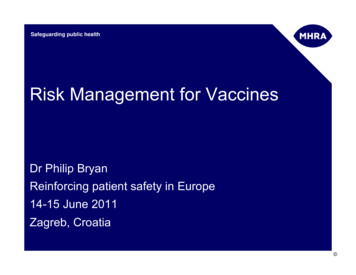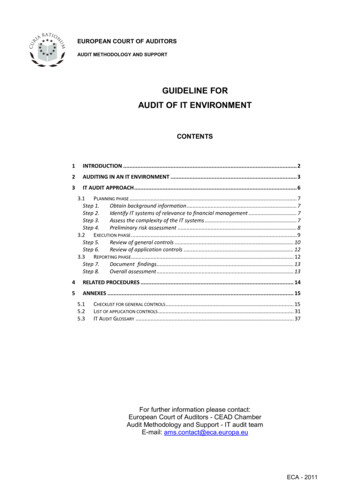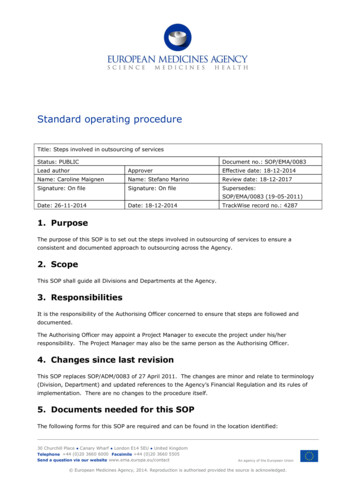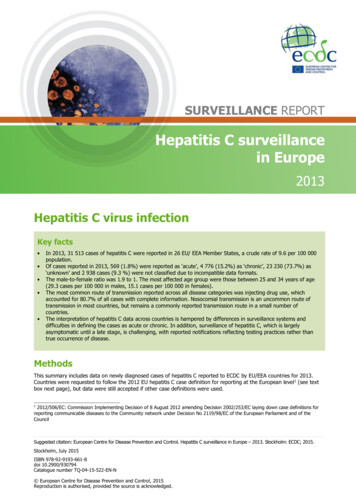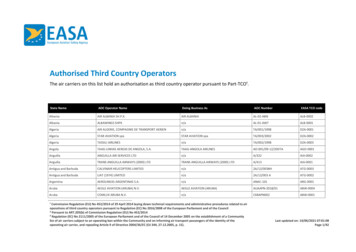
Transcription
ANNEX ISUMMARY OF PRODUCT CHARACTERISTICS1
1.NAME OF THE MEDICINAL PRODUCTPlegridy 63 micrograms solution for injection in pre-filled syringePlegridy 94 micrograms solution for injection in pre-filled syringePlegridy 125 micrograms solution for injection in pre-filled syringePlegridy 63 micrograms solution for injection in pre-filled penPlegridy 94 micrograms solution for injection in pre-filled penPlegridy 125 micrograms solution for injection in pre-filled pen2.QUALITATIVE AND QUANTITATIVE COMPOSITIONPlegridy 63 micrograms solution for injection in pre-filled syringe (for subcutaneous use)Each pre-filled syringe contains 63 micrograms of peginterferon beta-1a* in 0.5 mL solution forinjection.Plegridy 94 micrograms solution for injection in pre-filled syringe (for subcutaneous use)Each pre-filled syringe contains 94 micrograms of peginterferon beta-1a* in 0.5 mL solution forinjection.Plegridy 125 micrograms solution for injection in pre-filled syringe (for subcutaneous use)Each pre-filled syringe contains 125 micrograms of peginterferon beta-1a* in 0.5 mL solution forinjection.Plegridy 125 micrograms solution for injection in pre-filled syringe (for intramuscular use)Each pre-filled syringe contains 125 micrograms of peginterferon beta-1a* in 0.5 mL solution forinjection.Plegridy 63 micrograms solution for injection in pre-filled pen (for subcutaneous use)Each pre-filled pen contains 63 micrograms of peginterferon beta-1a* in 0.5 mL solution for injection.Plegridy 94 micrograms solution for injection in pre-filled pen (for subcutaneous use)Each pre-filled pen contains 94 micrograms of peginterferon beta-1a* in 0.5 mL solution for injection.Plegridy 125 micrograms solution for injection in pre-filled pen (for subcutaneous use)Each pre-filledpen contains 125 micrograms of peginterferon beta-1a* in 0.5 mL solution for injection.The dose indicates the quantity of the interferon beta-1a moiety of peginterferon beta-1a withoutconsideration of the PEG moiety attached.*The active substance, peginterferon beta-1a, is a covalent conjugate of interferon beta-1a, produced inChinese hamster ovary cells, with 20,000 Dalton (20 kDa) methoxy poly(ethyleneglycol) using anO-2-methylpropionaldehyde linker.The potency of this medicinal product should not be compared to the one of another pegylated ornon-pegylated protein of the same therapeutic class. For more information see section 5.1.For the full list of excipients, see section 6.1.3.PHARMACEUTICAL FORMSolution for injection (injection).Clear and colourless solution with pH 4.5-5.1.2
4.CLINICAL PARTICULARS4.1Therapeutic indicationsPlegridy is indicated in adult patients for the treatment of relapsing remitting multiple sclerosis (seesection 5.1).4.2Posology and method of administrationTreatment should be initiated under supervision of a physician experienced in the treatment of multiplesclerosis.Plegridy may be administered subcutaneously (SC) using a single-use pre-filled pen or pre-filledsyringe or intramuscularly (IM) using a single use pre-filled syringe.Efficacy of peginterferon beta-1a administered subcutaneously has been demonstrated over placebo.Direct comparative data for peginterferon beta-1a versus non-pegylated interferon beta or data onefficacy of peginterferon beta-1a after switching from a non-pegylated interferon beta are notavailable. This should be considered when switching patients between pegylated and non-pegylatedinterferons (see section 5.1).PosologyThe recommended dose of Plegridy is 125 micrograms injected SC or IM every 2 weeks (14 days).Treatment initiationIt is generally recommended that patients start SC or IM treatment with 63 micrograms at dose 1 (onday 0), increasing to 94 micrograms at dose 2 (on day 14), reaching the full dose of 125 microgramsby dose 3 (on day 28) and continuing with the full dose (125 micrograms) every 2 weeks (14 days)thereafter (see Table 1a for SC use or Table 1b for IM use).Subcutaneous routeAn initiation pack is available containing the first 2 doses (63 micrograms and 94 micrograms).Table 1a: Titration schedule at initiation via SC routeDoseTime*Amount (micrograms)Dose 1Day 063Dose 2Day 1494Dose 3Day 28125 (full dose)*Dosed every 2 weeks (14 days)Syringe labelOrangeBlueGreyIntramuscular routeAn administration dose pack contains the full 125 microgram dose in 1 pre-filled syringe.The Plegridy titration clips, designed for use with the pre-filled syringe are intended to limit the dosethat is administered to 63 micrograms (dose 1 (1/2 dose), yellow titration clip) and 94 micrograms(dose 2 (3/4 dose), purple titration clip), for day 0 and day 14 respectively. Each Plegridy titration clipshould be used once, and then discarded along with any remaining medicinal product. Patients shoulduse the full dose of 125 micrograms (no clip required) from day 28 onwards (dosing every 14 days).Table 1b Titration schedule at initiation via IM routeDoseTime*Amount (micrograms)Dose 1Day 063Dose 2Day 1494Dose 3Day 28125 (full dose)*Dosed every 2 weeks (14 days)3Titration clipYellowPurpleNo clips needed
Dose titration at the initiation of treatment may help to ameliorate flu-like symptoms that can occur attreatment initiation with interferons. Prophylactic and concurrent use of anti-inflammatory, analgesicand/or antipyretic treatments may prevent or ameliorate flu-like symptoms sometimes experiencedduring interferon treatment (see section 4.8).Switching between the SC and IM routes of administration and vice versa has not been studied. Basedupon bioequivalence demonstrated between the two routes of administration it is not expected thatdose titration will be required if switching between SC and IM, or vice versa (see sections 5.1 and 5.2).If a dose is missed, it should be administered as soon as possible. If 7 days or more to the next planned dose: Patients should administer their missed doseimmediately. Treatment can then continue with the next scheduled dose as planned. If less than 7 days to the next planned dose: Patients should begin a new 2 week dosing schedulestarting from when they administer their missed dose. A patient should not administer two dosesof peginterferon beta-1a within 7 days of each other.Special populationsElderly populationThe safety and efficacy of peginterferon beta-1a in patients over the age of 65 have not beensufficiently studied due to the limited number of such patients included in clinical trials.Renal impairmentNo dosage adjustments are necessary in patients with renal impairment based on study data in mild,moderate, and severe renal impairment and end stage renal disease (see sections 4.4 and 5.2).Hepatic impairmentPeginterferon beta-1a has not been studied in patients with hepatic impairment (see section 4.4).Paediatric populationThe safety and efficacy of peginterferon beta-1a in children and adolescents aged 0 to 18 years havenot been established in multiple sclerosis. No data are available.Method of administrationIt is recommended that a healthcare professional trains patients in the proper technique for self—administering SC injections using the SC pre-filled syringe/pre-filled pen or IM injections using theIM pre-filled syringes as appropriate. Patients should be advised to rotate sites for SC or IM injectionsevery two weeks. The usual sites for subcutaneous injections include abdomen, arm, and thigh. Theusual site for intramuscular injection is the thigh.Each Plegridy pre-filled pen/syringe for SC is provided with the needle pre-attached. Plegridy prefilledsyringe for IM use is supplied as a prefilled syringe with a separate needle for IM use.Both IM and SC pre-filled syringes and SC pre-filled pens are for single use only and should be discardedafter use.Precautions to be taken before handling or administering the medicinal productOnce removed from the refrigerator, Plegridy should be allowed to warm to room temperature (up to25 C) for about 30 minutes prior to injection. External heat sources such as hot water must not beused to warm the medicinal productPlegridy pre-filled syringe must not be used if the liquid is coloured, cloudy, or contains floatingparticles. The liquid in the syringe must be clear and colourless.4
Plegridy pre-filled pen must not be used unless the green stripes are visible in the pen injection statuswindow. Plegridy pre-filled pen must not be used if the liquid is coloured, cloudy, or contains floatingparticles. The liquid in the medicinal product window must be clear and colourless.4.3Contraindications-Hypersensitivity to natural or recombinant interferon beta or peginterferon or to any of theexcipients listed in section 6.1.Patients with current severe depression and/or suicidal ideation (see sections 4.4 and 4.8).4.4Special warnings and precautions for useTraceabilityIn order to improve the traceability of biological medicinal products, the name and the batch numberof the administered product should be clearly recorded.Hepatic injuryElevated serum hepatic transaminase levels, hepatitis, autoimmune hepatitis and rare cases of severehepatic failure have been reported with interferon beta medicinal products. Elevations in hepaticenzymes have been observed with the use of peginterferon beta-1a. Patients should be monitored forsigns of hepatic injury (see section 4.8).DepressionPeginterferon beta-1a should be administered with caution to patients with previous depressivedisorders (see section 4.3). Depression occurs with increased frequency in the multiple sclerosispopulation and in association with interferon use. Patients should be advised to immediately report anysymptoms of depression and/or suicidal ideation to their prescribing physician.Patients exhibiting depression should be monitored closely during therapy and treated appropriately.Cessation of therapy with peginterferon beta-1a should be considered (see section 4.8).Hypersensitivity reactionsSerious hypersensitivity reactions including cases of anaphylaxis have been reported as a rarecomplication of treatment with interferon beta, including peginterferon beta-1a. Patients should beadvised to discontinue treatment with peginterferon beta-1a and seek immediate medical care if theyexperience signs and symptoms of anaphylaxis or severe hypersensitivity. Treatment withpeginterferon beta-1a should not be restarted (see section 4.8).Injection site reactionsInjection site reactions, including injection site necrosis, have been reported with the use ofsubcutaneous interferon beta. To minimise the risk of injection site reactions patients should beinstructed in the use of an aseptic injection technique. The procedure for the self-administration by thepatient should be reviewed periodically especially if injection site reactions have occurred. If thepatient experiences any break in the skin, which may be accompanied by swelling or drainage of fluidfrom the injection site, the patient should be advised to speak with their doctor. One patient treatedwith peginterferon beta-1a in clinical trials experienced an injection site necrosis with SCpeginterferon beta-1a. Whether to discontinue therapy following a single site of necrosis is dependenton the extent of necrosis (see section 4.8).5
Decreased peripheral blood countsDecreased peripheral blood counts in all cell lines, including rare pancytopenia and severethrombocytopenia, have been reported in patients receiving interferon beta. Cytopenias, including raresevere neutropenia and thrombocytopenia, have been observed in patients treated with peginterferonbeta-1a. Patients should be monitored for symptoms or signs of decreased peripheral blood counts (seesection 4.8).Renal and urinary disordersNephrotic syndrome (class effects)Cases of nephrotic syndrome with different underlying nephropathies including collapsing focalsegmental glomerulosclerosis (FSGS), minimal change disease (MCD), membranoproliferativeglomerulonephritis (MPGN) and membranous glomerulopathy (MGN) have been reported duringtreatment with interferon-beta products. Events were reported at various time points during treatmentand may occur after several years of treatment with interferon beta. Periodic monitoring of early signsor symptoms, e.g. oedema, proteinuria and impaired renal function is recommended, especially inpatients at higher risk of renal disease. Prompt treatment of nephrotic syndrome is required anddiscontinuation of treatment with peginterferon beta-1a should be considered.Severe renal impairmentCaution should be used when administering peginterferon beta-1a to patients with severe renalimpairment.Thrombotic microangiopathy (TMA) (class effects)Cases of TMA, manifested as thrombotic thrombocytopenic purpura (TTP) or haemolytic uraemicsyndrome (HUS), including fatal cases, have been reported with interferon beta products. Events werereported at various time points during treatment and may occur several weeks to several years afterstarting treatment with interferon beta. Early clinical features include thrombocytopenia, new onsethypertension, fever, central nervous system symptoms (e.g. confusion, paresis) and impaired renalfunction. Laboratory findings suggestive of TMA include decreased platelet counts, increased serumlactate dehydrogenase (LDH) due to haemolysis and schistocytes (erythrocyte fragmentation) on ablood film. Therefore if clinical features of TMA are observed, further testing of blood platelet levels,serum LDH, blood films and renal function is recommended. If TMA is diagnosed, prompt treatmentis required (considering plasma exchange) and immediate discontinuation of peginterferon beta-1a isrecommended.Laboratory abnormalitiesLaboratory abnormalities are associated with the use of interferons. In addition to those laboratorytests normally required for monitoring patients with multiple sclerosis, complete blood and differentialblood cell counts, platelet counts, and blood chemistries, including liver function tests (e.g. aspartateaminotransferase (AST), alanine aminotransaminase (ALT)), are recommended prior to initiation andat regular intervals following introduction of peginterferon beta-1a therapy and then periodicallythereafter in the absence of clinical symptoms.Patients with myelosuppression may require more intensive monitoring of complete blood cell counts,with differential and platelet counts.Hypothyroidism and hyperthyroidism have been observed with the use of interferon beta products.Regular thyroid function tests are recommended in patients with a history of thyroid dysfunction or asclinically indicated.SeizurePeginterferon beta-1a should be administered with caution to patients with a history of seizures, to6
those receiving treatment with anti-epileptics, particularly if their epilepsy is not adequately controlledwith anti-epileptics (see section 4.8).Cardiac diseaseWorsening of cardiac disease has been reported in patients receiving interferon beta. The incidence ofcardiovascular events was similar between peginterferon beta-1a (125 micrograms every 2 weeks) andplacebo treatment groups (7% in each group). No serious cardiovascular events were reported inpatients who received peginterferon beta-1a in the ADVANCE study. Nevertheless, patients with preexisting- significant cardiac disease, such as congestive heart failure, coronary artery disease orarrhythmia should be monitored for worsening of their cardiac condition, particularly during initiationof treatment.ImmunogenicityPatients may develop antibodies to peginterferon beta-1a. Data from patients treated up to 2 years withpeginterferon beta-1a administered SC suggests that less than 1% (5/715) developed persistentneutralising- antibodies to the interferon beta-1a portion of peginterferon beta-1a. Neutralisingantibodies have the potential to reduce clinical efficacy. However, the development of antibodiesagainst the interferon moiety of peginterferon beta-1a had no discernible impact on safety or clinicalefficacy, although the analysis was limited by the low immunogenicity incidence.Three percent of patients (18/681) developed persistent antibodies to the PEG moiety of peginterferonbeta-1a. In the clinical study conducted, the development of antibodies against the PEG moiety ofpeginterferon beta-1a had no discernible impact on safety, or clinical efficacy (including annualisedrelapse rate, magnetic resonance imaging (MRI) lesions, and disability progression).Hepatic impairmentCaution should be used and close monitoring considered when administering peginterferon beta-1a topatients with severe hepatic impairment. Patients should be monitored for signs of hepatic injury andcaution exercised when interferons are used concomitantly with other medicinal products associatedwith hepatic injury (see sections 4.8 and 5.2).Sodium contentThis medicinal product contains less than 1 mmol (23 mg) sodium, that is to say it is essentially“sodium-free”.4.5Interaction with other medicinal products and other forms of interactionNo interaction studies have been performed. The clinical studies indicate that multiple sclerosispatients can receive peginterferon beta-1a and corticosteroids during relapses. Interferons have beenreported to reduce the activity of hepatic cytochrome P450-dependent enzymes in humans andanimals. Caution should be exercised when peginterferon beta-1a is administered in combination withmedicinal products that have a narrow therapeutic index and are largely dependent on the hepaticcytochrome P450 system for clearance, e.g. some classes of antiepileptics and antidepressants.4.6Fertility, pregnancy and lactationPregnancyA large amount of data (more than 1,000 pregnancy outcomes) from registries and post-marketingexperience indicates no increased risk of major congenital anomalies after pre-conception exposure tointerferon beta or such exposure during the first trimester of pregnancy. However, the duration ofexposure during the first trimester is uncertain, because data were collected when interferon beta use7
was contraindicated during pregnancy, and treatment likely interrupted when pregnancy was detectedand/or confirmed. Experience with exposure during the second and third trimester is very limited.Based on animal data (see section 5.3), there is a possibly increased risk for spontaneous abortion.The risk of spontaneous abortions in pregnant women exposed to interferon beta cannot adequately beevaluated based on the currently available data, but the data do not suggest an increased risk so far.If clinically needed, the use of peginterferon beta-1ay may be considered during pregnancy.Breast-feedingIt is not known whether peginterferon beta-1a is secreted in human milk. Limited informationavailable on the transfer of interferon beta-1a into breast milk, together with the chemical /physiological characteristics of interferon beta, suggests that levels of interferon beta-1a excreted inhuman milk are negligible. No harmful effects on the breastfed newborn/infant are anticipated.Peginterferon beta-1a can be used during breast-feeding.FertilityThere are no data on the effects of peginterferon beta-1a on human fertility. In animals, anovulatoryeffects were observed at very high doses (see section 5.3). No information is available on the effectsof peginterferon beta-1a on male fertility in animals.4.7Effects on ability to drive and use machinesPeginterferon beta-1a has no or negligible influence on the ability to drive and use machines.4.8Undesirable effectsSummary of safety profileThe most common adverse drug reactions (ADR) (at a higher incidence than placebo) forPeginterferon beta-1a 125 micrograms subcutaneously every 2 weeks were injection site erythema,influenza like illness, pyrexia, headache, myalgia, chills, injection site pain, asthenia, injection sitepruritus, and arthralgia.The most commonly reported adverse reaction leading to discontinuation in patients treated withpeginterferon beta-1a 125 micrograms subcutaneously every 2 weeks was influenza-like illness ( 1%).Tabulated list of ad
Plegridy 63 micrograms solution for injection in pre-filled syringe . . symptoms of depression and/or suicidal ideation to their prescribing physician. Patients exhibiting depression should be mo
